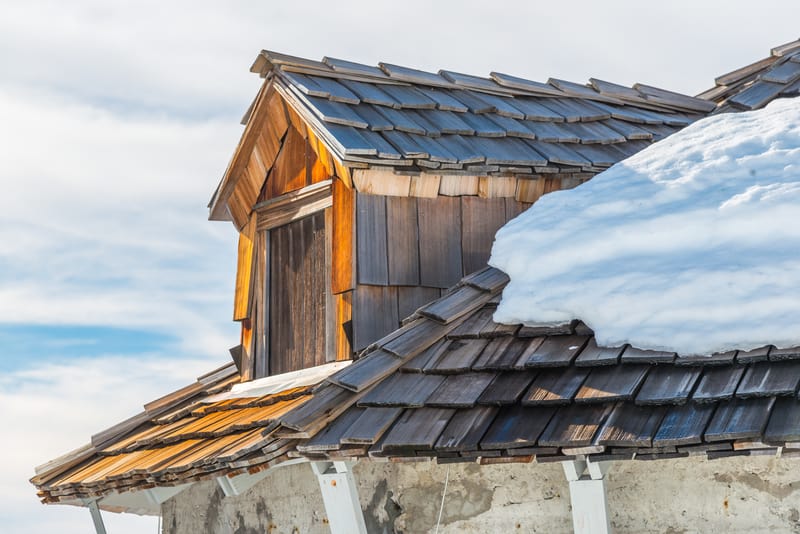
Deciding what to use when redoing your roof can be overwhelming.
There are so many options available, each with their own pros and cons.
If you can match your roofing and climate you can save thousands of dollars over the life of your roof.
See our recommendations below to find out more about available roofing materials.
Roofing and Climate
The best place to start when choosing the roof for your needs is climate. There are major differences between a hot and cold weather roof.
Hot weather roofs are all about reflecting heat or resisting it’s spread. These kinds of roofs work well with built-in airflow and an insulative material.
Cold weather roofs need to be very sturdy. They have to resist the weight of snow and ice that can build up over the course of a winter.
They need to be insulated but allow heat to reach the roof from the house below. This keeps the roof temperature above freezing and helps melt off layers of ice and snow.
Here are some of the best materials for hot or cold roofs.
Asphalt & Cedar
Shingles, and especially asphalt shingles, are one of the most common types of roofing materials. They’re relatively inexpensive and do an excellent job protecting the home from the elements.
Asphalt shingles are the most popular type of shingles used in American homes. They’re inexpensive, come in a variety of sizes and colors, and are easy to install.
They use either a fiberglass or felt backing that is then soaked in asphalt and covered with ceramic granules. This makes them waterproof and helps reflect the sun’s rays away from the roof.
They work well in hot or cold climates. The strength of shingles comes from the structure below them. They can hold just as much snow as the building itself can.
Cedar is a higher-end variety of shingle that many homeowners find very attractive. They give the home a rustic appearance without sacrificing utility.
Tile
Tile has traditionally been used in hot climates and does a great job reducing heat. They have two natural advantages over other roofing materials.
Roofing tiles are generally much thicker than other varieties of roofing. This lets them act as a better insulator than any other roofing material.
They absorb the heat on the surface but prevent it from getting into the house below. The other key advantage is the way they are applied to your roof.
Tiles are placed in regular patterns that cause them to overlap and overhang other tiles. This creates natural airflow that helps them radiate absorbed heat off into the air.
The same insulating properties that keep the heat out also keeps the warmth in. During winter months tile roofing serves as a natural insulator on top of other material.
This helps reduce energy costs in the height of summer and the dead of winter.
They have a history of use in the American Southwest and are a great example of roofing and climate matched together.
Metal
Metal roofs are a great option for people in hotter climates. They’re durable, long lasting and can stand up to a lot of abuse.
They’re great for warmer climates because of the high reflectivity of metal. The reflective surfaces of metal roofs bounce away solar radiation and reduce the transfer of heat.
Metal roofs serve a purpose during the winter as well. They do an excellent job standing up to heavy loads of snow and ice.
They are more expensive than a traditional asphalt roof but they last much longer. The typical lifespan of a metal roof is 40-70 years. Compare this to just 12-20 years for an asphalt roof.
You can see the tradeoff. Investing more in a metal roof is a good move over the long haul.
There are several common materials used in metal roofing. They start at inexpensive steel and go up to very high-end bronze roofing.
Slate
Slate roofs are an excellent way to protect your home from both summer heat and winter storms. They’re reflective, highly insulative, long-lasting and visually stunning.
Slate is an undeniably durable roofing material. A quality slate roof can last for more than a century with minimal upkeep.
Slate is a natural stone, giving it a high density. This makes it absorb and retain the heat of the day without transferring it to the house below.
It works well for colder climates too. Slate is very hard and has a smooth surface. Snow doesn’t accumulate well on slate roofs.
It’s not without downsides of course. Slate roofs are extremely heavy and require specialized installation. It’s very important to have your home inspected before installing a slate roof.
Slate is also quite expensive compared to other roofing materials. It’s definitely a long-term investment. Generally, slate is used on structures to add class and finish off the look of a high-end property.
If you can look past the high price tag and difficult installation, slate is a great material to use for matching your roofing and climate.
Solar Roofing
Solar panels and solar tiles are a very new type of roofing material. Panels themselves should be seen as an add-on to a regular roof rather than the roof itself.
These roof materials can give a great return if properly paired with your climate. The Southwest, in particular, is great for adding solar products to cut energy and cooling bills.
The panels not only produce electricity, they also serve to shade the roof beneath them. This both lowers bills and cools the house.
Solar tiles are very new. They work on the same physical design as traditional shingles or clay tiles. They provide many of the benefits of each of these designs, such as airflow, while also generating electrical power.
New Trends
These are just some of the most common types of roofing materials. If you want to find a perfect match between your roofing and climate there are many other options available.
Find out more about available roof materials and the climate they’re best suited for here.

